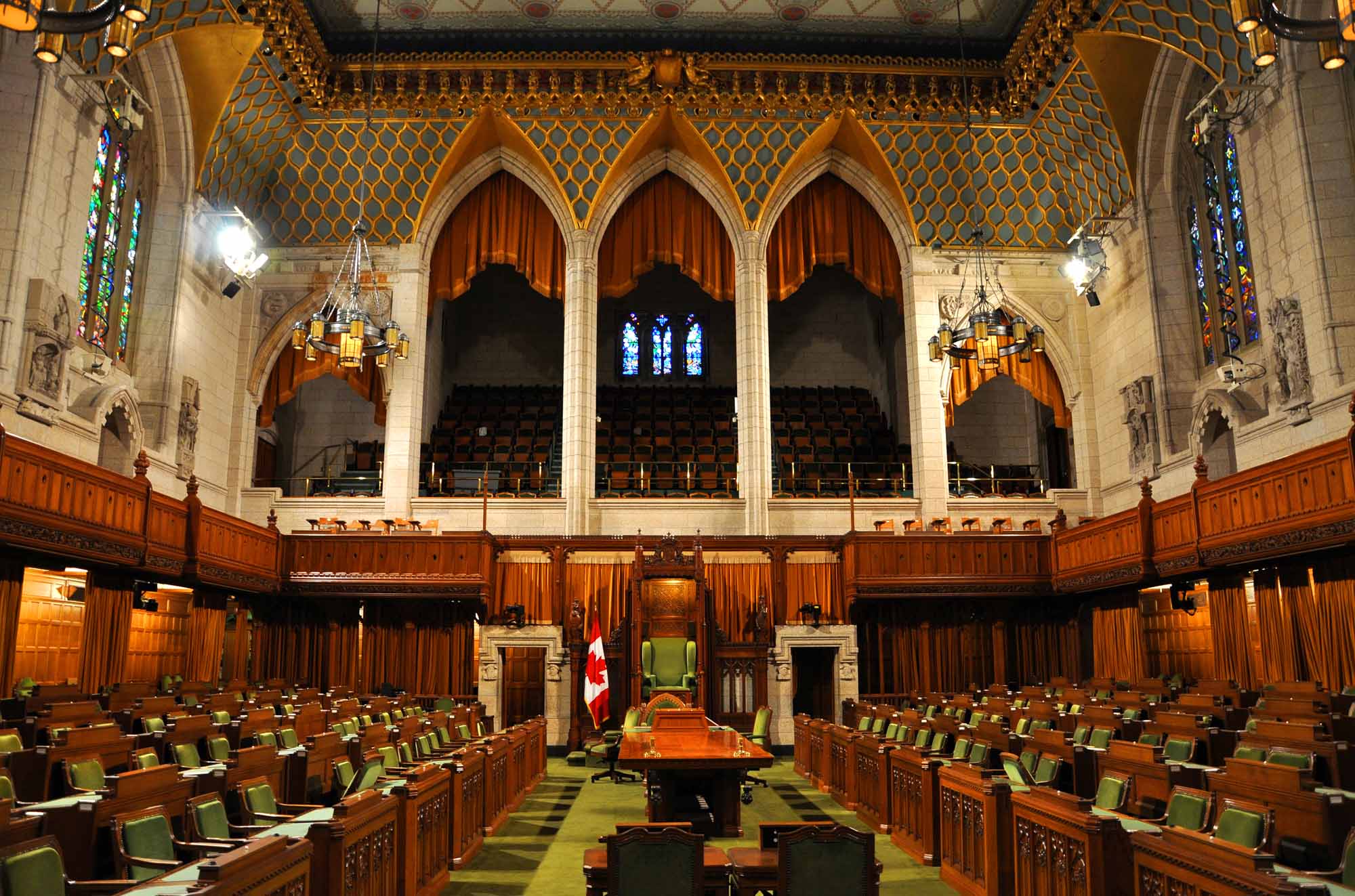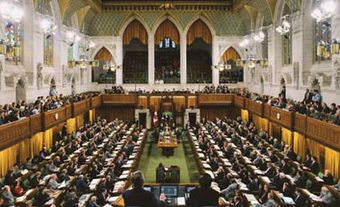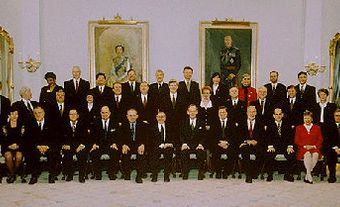The House of Commons is the centre of political power in Canada. The prime minister and his or her Cabinet receive their authority through the confidence of the House. It is an institution steeped in tradition and history. In recent years, Question Period has been televised, opening the political process to Canadians. Much of what the public sees is the rancorous
debate and partisan bickering among political parties but the House of Commons is also where most government legislation is introduced, and where Members of Parliament meet to debate policy, vote on key legislation, and hold the government to account.

Role of the House of Commons
The House of Commons is the elected lower house of Parliament. It consists of a Speaker (traditionally chosen from the party in power but now elected from the House by secret ballot), the prime minister and his or her Cabinet, members of the governing party, members of the opposition parties and the Official Opposition's shadow government, and backbenchers. There are sometimes a few independent members. The 338 members of the House (called Members of Parliament, or MPs) are elected in single-member constituency elections or by-elections.
Under the Constitution Act 1867, the Queen and the Governor General and the Queen's ministers and other public servants, not the House of Commons, govern Canada. Those ministers, however, are responsible to the House (see Responsible Government). The House, often incorrectly referred to as Parliament, is important constitutionally because no new statutes may be created except in response to bills that have been passed by the House. It is important politically because, unlike the Senate or upper house, it is an independent, elected body. Ministers are responsible to the House, not to the Senate.
Non-financial bills may be introduced in the Senate as well as in the House, but under the Constitution Act, both taxation bills and appropriation bills must have passed the House before going to the Senate. Although private members may introduce taxation bills, under the Act (s54), only the Crown may initiate spending (supply) business.
The House’s constitutional function is to maintain a government for a reasonable time. To defeat one government after another in rapid succession would be anarchistic, a point which becomes highly relevant when no party wins a majority, as happened in six of the nine elections between 1957 and 1979, and again in the successive elections of 2004 and 2006. The political function of the House is to foster government acceptable to the people, and it has the power to insist that ministers account for their conduct and their bills and policies.
Question Period and Accountability
Questions may be written down and placed on the Order Paper to receive a printed reply but during oral Question Period (45 minutes daily) ministers may be questioned directly (see Parliamentary Procedures). Usually, Opposition MPs ask the questions.
The House can bring down a government. Elections were held after the House defeated minority governments in 1963, 1974, 1979 and 2005. In recent years, the controversy over ministerial responsibility and the growth of executive power (sometimes referred to as "Cabinet dictatorship" or "concentration of power in the hands of the Prime Minister's Office") has generated considerable debate over the role, function and relevance of the House. The extent to which individual ministers should be held accountable for the actions of civil servants in their departments is also a subject of much debate in the highly partisan atmosphere that pervades the House of Commons.
In Canada, Parliament is expected to serve as an auditor of executive government, examining bills, policies and conduct. House Committees have become increasingly useful for these purposes. The role of the media in covering parliamentary debate and generating public opinion is of critical importance. The decision of the House to publish its debates in the form of a bilingual Hansard and, more recently, to allow continuous television coverage when the House is in session (on the publicly supported Cable Public Affairs Channel, or CPAC) were prompted in part by dissatisfaction with the news media.
Opposition Parties
In order for a party to be recognized in the House, it must have 12 or more Members of Parliament. Such recognition entitles the party to committee assignments, research support and being called upon by the Speaker more frequently to ask questions of the government. Since 1974, election ballots have shown the candidates' party allegiances, if any, to voters. Members sometimes "cross the floor" to another party or leave their party, by choice, or after being removed from caucus by their leader, and will sit as independents. This does not happen often.
The Opposition is allotted up to twenty-five days in three supply periods to determine the subject of debate in the House. Supply periods occur when the government is seeking passage of spending bills (see Budgetary Process). The Opposition may also make motions to discuss an urgent, unexpected matter. The debate on the Speech from the Throne and the debate on the budget are general debates.
Parliamentary Privilege
At the beginning of each Parliament, the privileges of the House of Commons are confirmed by the governor general. This stems from the tradition at Westminster, where it was found that if the House was to participate effectively it had to have certain privileges and certain exemptions from ordinary law. For a long time, one of the foremost privileges at Westminster was that its members could not be imprisoned for debt. In Canada, members have the right to speak freely — without being liable to prosecution in the courts — in proceedings of the House and its committees. MPs cannot say anything they please; the House has a responsibility to control its members and to protect ordinary citizens from vilification.
MPs may be accused of contempt and of misleading the House. In 1982, the Speaker considered a breach-of-privilege complaint against the minister of justice. The House may admonish or censure offenders and is empowered to imprison them for the balance of the session. Genuine questions of privilege and contempt are serious but very rare; however, many members use points of privilege, which take precedence over most other business, to get the floor merely to voice complaints or to make corrections.
Role of the Speaker
All speeches in the House are addressed to the Speaker, although direct exchanges often break out in the heat of debate. Private members are referred to by the name of their constituencies (i.e., "the Honourable Member for Peace River") and ministers by office (i.e., "the Honourable the Minister of Finance"). The House does not permit members to use unparliamentary language because it fosters bitterness and reflects on the honour of the House but, in recent years, the Speaker has been under increasing pressure to keep things civilized. Some expressions deemed unparliamentary include "sick animal," "pompous ass," "lies," "Nazi" and "stinker." In 1971, A Conservative MP alleged that Prime Minister Pierre Trudeau told him to f--- off, but Trudeau famously denied swearing in the House, claiming he said “fuddle duddle.” And in 1985, Conservative MP John Crosbie caused an uproar after telling Liberal MP Sheila Copps, “Quiet down, baby."
The Speaker is the chief officer of the House and his election is the prime order of business when the House reassembles after a general election. The Speaker decides who has the floor, applies the rules of procedure, makes rulings, and manages the administration of the House and its employees. He must be impartial and does not participate in debates and will only vote when there is a tie. There have been unsuccessful attempts to make the position permanent — as it is at Westminster. The Deputy Speaker occupies the Speaker's chair if he is absent and chairs the committee of the whole. The Clerk of the House sits at a table in front of the Speaker, dressed in a black robe, and he and the other table officers supply the Speaker with advice and information.
When the first parliaments were held at Westminster, the king sent a royal sergeant-at-arms, bearing a royal mace, to the House of Commons to show that the House was under the king's protection and was not to be threatened. In Ottawa, the sergeant-at-arms occupies a special chair in the centre aisle and he leads the procession when the Speaker enters the chamber or proceeds to the Senate chamber for speeches from the throne, royal assents and prorogations. The sergeant-at-arms carries the mace, a symbol of the authority of the House vested in the Speaker, and places it on the table when the Speaker takes his seat.
The Commons Chamber
The House of Commons meets in the Commons chamber at the west end of the Centre Block of the Parliament Buildings. The main doors of the chamber are at the south end — this is where the Gentleman Usher of the Black Rod raps when he comes to summon the Commons to the Senate chamber. There is a telescoping brass rail known as the Bar at the foot of the centre aisle of the chamber, just inside the main doors, which can be extended across the aisle. One of its original functions at Westminster was to keep strangers from mingling and perhaps voting with the members. Occasionally, strangers have been summoned to appear at the Bar of the House to be questioned or censured but otherwise the public and press do not go into the chamber and view proceedings instead from the galleries above.
Every member has an assigned seat in the chamber and must be in his place to speak and vote in the House. There are five rows of desks down each of the long sides of the room; these two banks of desks face each other across a wide centre aisle, with the Government on one side and the Opposition on the other. The Speaker's chair is at the north end of the centre aisle. This arrangement supposedly originated in the days when the English House met in St Stephen's Chapel, and it suits the adversarial nature of Canada’s responsible government system.
The prime minister occupies the 13th place in the front row on the west side, while the leader of the Opposition sits directly opposite. The other ministers are grouped in a block of seats around the prime minister. The leader of the Opposition also has key followers around him. Former ministers — styled "the Honourable" as members of the Privy Council, a title they retain for life — are given seats in the front rows, at either the north or south end. The leader of each party, through the Party Whip, fixes the party seating plan — invariably by class (year of first election) and alphabetically within classes.
The Commons convenes Monday through Friday and normally adjourns at 6:30 p.m, except for Fridays. Emergency debates, though, can run past midnight. In 1913, before there was a fixed time for adjournment, two different sittings extended throughout an entire week. A record was set in 1982, during the "long-bell sitting," which began on 2 March and did not end until 17 March. The issue was the Opposition's concern with the Energy Security Bill proposed by the Trudeau government.

A Growing Chamber
In 2011, the House of Commons passed a bill to expand the chamber by 30 seats in time for the 2015 election. It was supported by the majority Conservative government — which introduced the bill to better represent the country’s fastest growing provinces — but opposed by the Liberals and New Democratic Party. The NDP was against giving Quebec more seats and the Liberals wanted to keep the same number of seats but reorganize the distribution more equitably. The change will expand the Commons to 338 seats, with Ontario getting 15 new MPs and BC and Alberta getting six more each. Québec will also get three more, although the province is already slightly overrepresented. It is expected to cost more than $34-million.
Did you know? Enfranchised women in Canada first gained the right to stand for theHouse of Commons on 7 July 1919 (see Women’s Suffrage in Canada). In the 1921 general federal election, Agnes Campbell Macphail became the first woman elected to Parliament. She would remain the only female MP in the House of Commons until Martha Louise Black was elected in the 1935 federal general election.
Summons and Prorogation
Sessions of Parliament begin with a summons and end with prorogation (suspension), both of which are issued by the governor general at the government’s request. Minority parliaments recently have lasted only one or two sessions. Between 1867 and 1938, the annual sessions lasted only a few months; now they normally run a full year, with three long adjournments. The main purpose of prorogation is to wipe clean the Order Paper of old or existing business, and to set a new legislative agenda. All business unfinished at the end of a session—unanswered questions and all orders relating to bills and motions — die on the Order Paper.
Prorogation has become a heated political issue in recent years. Controversy erupted in 2008 when Prime Minister Stephen Harper asked Governor General Michaëlle Jean to prorogue Parliament shortly before a confidence vote that could have defeated his minority Conservative government and replaced it with a coalition NDP-Liberal regime supported by the Bloc Québécois. Amid intense public and media scrutiny, Jean agreed to Harper's request, after consulting constitutional experts. The Conservative government survived.
In 2009 Harper again asked the governor general to prorogue Parliament for two months, arguing that his government needed to consult with Canadians and businesses as it dealt with economic issues. The move, however, was widely criticized as a tactic allowing the government time to gain a majority on Senate committees. It was also seen as a strategic move to avoid investigations into allegations that the government had ignored warnings about the torture of detainees in the Afghanistan war.
The 2009 episode led to a broader debate about whether or not governments were using prorogation as a political tool to further their own causes.
Centre Block Renovation
In 2019, Parliament Hill’s Centre Block closed its doors for a major renovation that is expected to last at least a decade. The project to restore, upgrade and modernize the Centre Block includes the House of Commons and Senate chambers, as well as the Peace Tower, the Library of Parliament, and offices for MPs and party leaders. While the building will be closed to visitors during the construction, the Hill – including the Great Lawn - remains open and Parliament continues to function. MPs are operating out of a temporary House of Commons located in the West Block and the Senate is working out of temporary chambers in the Senate of Canada Building (formerly named the Government Conference Centre).

 Share on Facebook
Share on Facebook Share on X
Share on X Share by Email
Share by Email Share on Google Classroom
Share on Google Classroom



